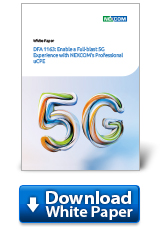DFA 1163: Enable a Full-blast 5G Experience with NEXCOM’s Professional uCPE
The Trend
In the 5G era, NG-RAN (new generation Radio Access Network) and 5GC (5G Core Network) together are forming infrastructure for 5G connectivity (Figure 1), which features 3 key advantages: high bandwidth, high reliability, and low latency. A single network infrastructure can enable diversified services based on cloud-native approach to hardware design, distributed software architecture, and automatic deployment. As a result, professional uCPE is required to adapt to the extensive cloudification of networks, operating systems and services at the edge for digital transformation.
The Challenge
Compared with legacy uCPE, professional uCPE has more features, including various I/O port types (SFP, SFP+, RJ45, PoE), greater Ethernet bandwidth, optimal performance, and multi-connectivity for enabling more connections (wired as well as wireless). SDN/NFV-based professional uCPE is adaptive, flexible for cloud-native applications at the edge, and able to run diversified services locally. Network slicing using SDN/NFV on a cloud-native unified architecture provides diversified services to the professional uCPE in NG-RAN. uCPE by leveraging multi-connectivity, high throughput and reliable latency is able to proceed even heavy load applications, such as Augmented Reality (AR), Virtual Reality (VR), assisted/automated driving and smart manufacturing applications.
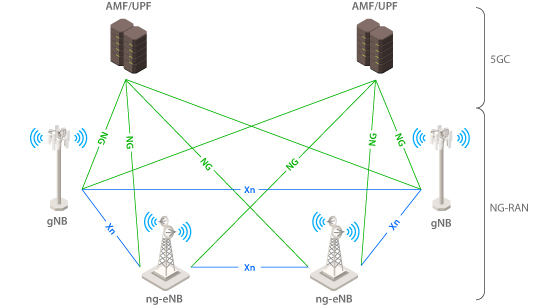
Figure 1. NG-RAN and 5GC in the 5G system.
With IoT devices increasing daily, and moving all aspects of life to online format, demand for low latency and high bandwidth connections is on the peak. In order to meet the high demand and provide a reserve for the future, mmWave technology is currently available. It covers 5G frequency range 2, which is within the 24 GHz and 300 GHz range, or more specifically, within the upper limits of radio waves and the range of microwaves. In comparison, LTE, LTE Advanced, and 5G sub-6GHz networks run below 1 GHz and within the mid-range bands of 3.4 GHz and 6 GHz (Figure 2). With mmWave technology enabled, users can enjoy eMBB (enhanced Mobile Broadband) experience with higher speeds and seamless connectivity across many applications. mmWave specification maximizes the full network potential of fifth-generation wireless connectivity, but network appliances supporting this technology are not ready to be mass produced to the market yet.
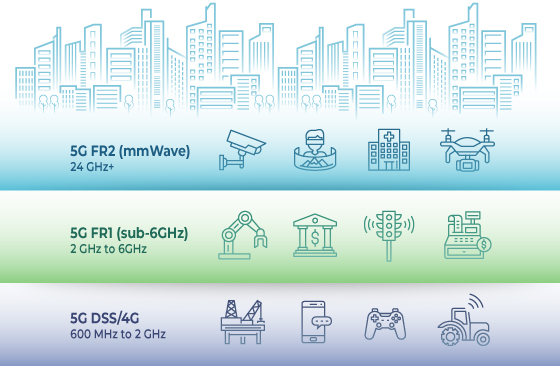
Figure 2. Frequency ranges in 5G System.
NEXCOM Solution
NEXCOM’s latest professional uCPE, DFA 1163 Series, is based on Intel® Atom® C3000 processor and designed to accommodate all of the applications mentioned above. It features Intel QAT® technology inside the CPU with built-in crypto engine to offload CPU workload. This professional uCPE integrates PoE+ function powering the IoT devices and Ethernet-based equipment. One 10GbE SFP+ fiber LAN port is added for data up-steam to the back-end Ethernet switches and further to central servers. Besides, DFA 1163 Series features copper ports with different link speeds, two 2.5GbE RJ45 ports, eight 1GbE Ethernet switch ports to enable Ethernet services for IoT devices, such as VLAN and QoS.
In addition, the latest wireless technologies--5G FR1 & FR2 and Wi-Fi 6 modules--are supported to fulfill wireless broadband connection in private and public 5G environments. An alternative way for WAN connectivity is traditional fixed-line Ethernet connection, which can be achieved by using xDSL SFP adapter plug into any of SFP ports. Yet this legacy option is facing a big wave of decommissioning in some places of the world.
One of DFA 1163 applications is to provide wireless broadband for Industry 4.0 devices based on FWA technology. By integrating eMBB and mMTC into uCPE, 5G services are localized inside uCPE to enable cloud-native applications in private network. Additionally, DFA 1163 can be used as wireless gateway, security gateway and edge computing uCPE for complex applications.
The performance of DFA 1163 for wired and wireless broadband connectivity, including 5G, Wi-Fi 6 and LAN, is shown in tables below. It was tested in both 5G environments--Non-Standalone (NSA) and Standalone (SA). NSA mode is based on the architecture where 5G services are provided without an end-to-end 5G network, but rely on previous generation (4G LTE) infrastructure, where eNB/en-gNB are based on EN-DC (LTE-NR Dual Connectivity) architecture (Figure 3). While in Standalone Architecture NG-RAN and 5GC are parts of 5G system (Figure 1) and do not depend on the 4G network infrastructure.
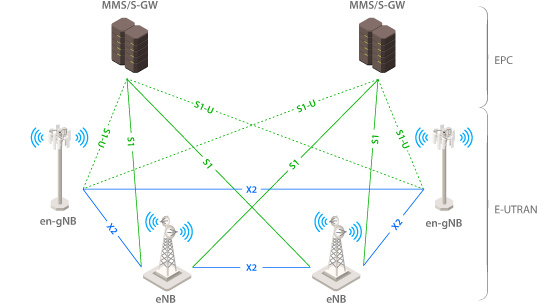
Figure 3. 5G NSA Architecture.
5G performance of DFA 1163 was validated in NSA environment of Chunghwa Telecom, Taiwan’s biggest mobile provider, for upload and download speeds. Test configuration is listed in Table 1 and the results of 5G data traffic between DFA 1163 and NSA NG-RAN are 108.02 Mbps for uploading and 866.56 Mbps for downloading, which meets general user experience for 5G data transmission.
TABLE 1. 5G NSA AND SA (FR1) TEST CONFIGURATION.
| Items | Description |
|---|---|
| System | DFA 1163A |
| CPU | C3758R |
| Memory | 64 GB |
| OS | Ubuntu 18.04.5 LTS 5.4.53 |
| Sub 6G module | Thales MV31-W |
5G performance test of DFA 1163 in SA environment was run by O’Prueba Technology Inc., a spin-off from the reputed Networking Benchmarking Lab (NBL) at National Chiao Tung University (NCTU) in Taiwan, with using AMARI Callbox, a 5G core network emulator, and IPerf tools for data traffic performance testing. For test configuration, please refer to Table 1. 5G data traffic from DFA 1163 goes through wireless connection to send/achieve data to/from AMARI Callbox, which simulates 5G gNB with UPF for package forwarding (IP, TCP UDP). Results for DFA 1163 in SA 5G environment are 15.7 Mbps for uploading and 306 Mbps for downloading (Table 3), which are just a referential numbers and are not defined as top limits.
For 5G FR2 testing, DTA 1163M SKU with mmWave antenna support was used, the configuration is shown below in Table 2. The test took place in a laboratory environment where 5G network was created. DFA 1163M was tested under 5G NR n257 frequency band, which equals to 28 GHz ± 100 MHz.
TABLE 2. 5G NSA (FR2) TEST CONFIGURATION.
| Items | Description |
|---|---|
| System | DFA 1163A |
| CPU | C3758R |
| Memory | 64 GB |
| OS | Ubuntu 18.04.5 LTS 5.4.53 |
| FR2 module | Thales MV31-W |
The results captured by test equipment are 1 Gbps for uploading and 3.8 Gbps for downloading, which exceeds 5G NSA and SA (FR1) results in terms of their Internet throughput, bringing data transfer speeds to a whole new level. All results for wireless performance are summed up and compared in the following table.
TABLE 3. COMPARISON TABLE OF DFA 1163 PERFORMANCE RESULTS FOR WIRELESS CONNECTIVITY.
| Testing Environment | Upload (Mbps) | Download (Mbps) |
|---|---|---|
| 5G NSA | 108.02 | 866.56 |
| 5G SA FR1 | 15.7 | 306 |
| 5G NSA FR2 (mmWave) | 1,053.18 | 3,825.9 |
| Wi-Fi 6 | 749 | 846 |
Performance for Wi-Fi 6 down- and up-streaming traffic were tested by commercial Wi-Fi AP router, attained results are 846 Mbps and 749 Mbps respectively. For Ethernet performance testing, the IXIA packet generator was used. Operating with IP forwarding in bi-direction mode, DFA 1163 showed outstanding results, which are summarized in Table 4.
TABLE 4. DFA 1163 ETHERNET THROUGHPUT PERFORMANCE
| Ethernet Throughput (%) | |||||
|---|---|---|---|---|---|
| Packet Size (Byte) | 10GbE | 2.5GbE | 1GbE (SFP) | 1GbE (RJ45) | GbE Ethernet Switch |
| 64 | 89.945 | 29.62 | 81.438 | 80.664 | 100 |
| 128 | 100 | 52.05 | 100 | 100 | 100 |
| 256 | 100 | 93.04 | 100 | 100 | 100 |
| 512 | 100 | 99.227 | 100 | 100 | 100 |
| 1024 | 100 | 100 | 100 | 100 | 100 |
| 1280 | 100 | 100 | 100 | 100 | 100 |
| 1518 | 100 | 100 | 100 | 100 | 100 |
Attained results validate that the DFA 1163 Series is ready to be deployed in both 5G NSA and SA networks. It was also shown to provide excellent Wi-Fi and Ethernet connectivity, making it a perfect professional uCPE for 5G public and private network in the long run.
Conclusion
Cloud-native deployments at the edge is the key for enabling diversified services in 5G Architecture. NEXCOM professional uCPE DFA 1163 Series is designed with a rich set of features to meet CommPRs’ service requirements for public and private networks. It features multi-core CPU and Intel QAT®, integrates optional 4G LTE, 5G (FR1 and FR2), Wi-Fi 5/6 modules, PoE+ and TSN switch for SDN/NFV, edge computing, wireless broadband gateway and networking security applications. NEXCOM’s DFA 1163 Series offers agility for multiple connectivity and high expandability in creating a securely connected workplace while experiencing the outstanding potential of the 5G network technology.
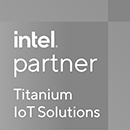
- Related Links:
- NEXCOM Servers Provide Edge Video AI Analytics and Processing
- NEXCOM Delivers Exceptional Performance in Edge AI Video Analytics
- Browse Other News:
- Built to Last, Built for AI The ATC 3750-IP7-8M Delivers Rugged Performance for AI Transportation
- NEXCOM NViS 57164/NViS 57244: Streamlining Security with Integrated PoE in a 1U Rackmount NVR
- All White Papers News


